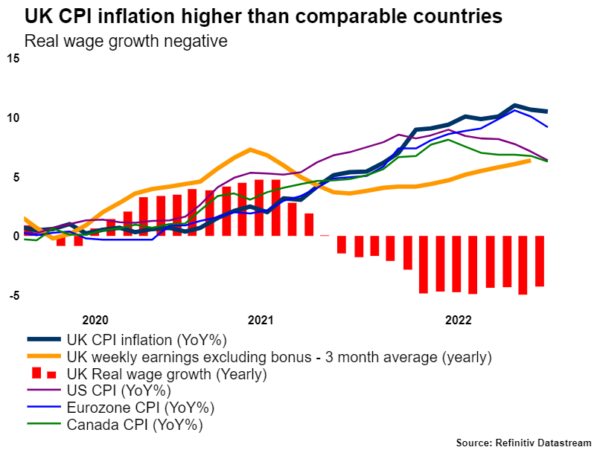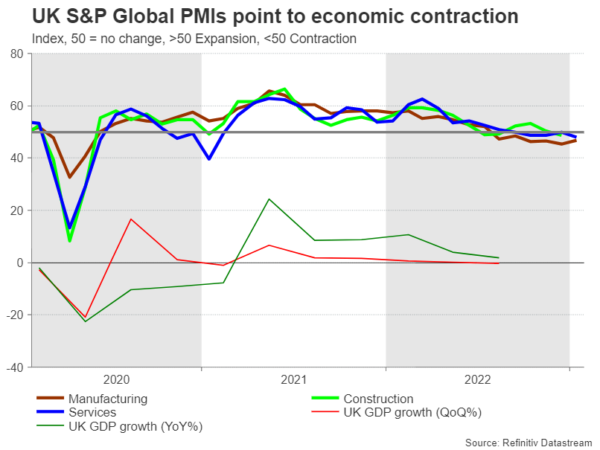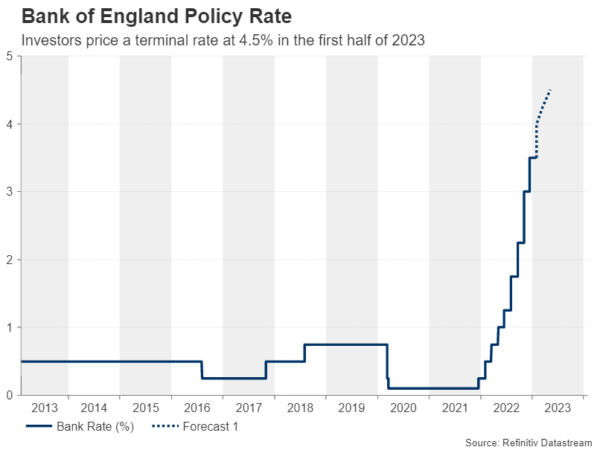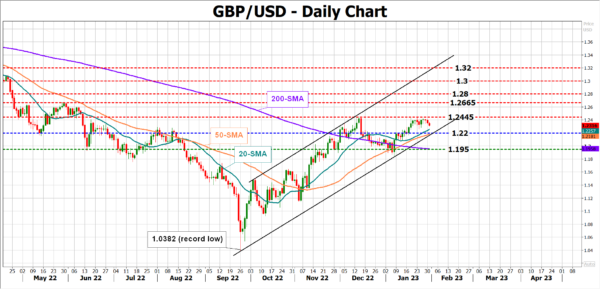The Bank of England will review its monetary policy on Thursday in what might turn out to be a live event as investors eagerly look for signs that rate differentials with the Fed will narrow this year. While a downshift to softer rate hikes is less likely to happen this time, pound traders may seek new tweaks in forward guidance before they drive the pound out of its short-term range. The policy announcement will be out at 12:00 GMT.
A slowdown in tightening might be premature
The Bank of England (BoE) has raised its interest rate from nearly zero to 3.5% over the past year, applying a more aggressive hiking strategy during the second semester as the inflation rate jumped to double digits for the first time in almost half a century. Global evidence has somewhat convinced central bankers that inflation is cooling now, with the Bank of Canada signaling a pause at its current interest rate, while the Fed flagged a slowdown to a 25bps rate hike in the forthcoming meeting . The BoE, however, may not follow suit.
The UK headline CPI clocked in at 10.5% y/y in December, down from 10.7% in November and 11.1% in October, but still far above the central bank’s 2.0% target, suggesting that the cost of living is still biting.
What was more concerning was the core measure, which stood stable at 6.3% y/y on the back of high housing and household services prices despite expectations for a soft decline. Hence, assuming that the price stability mandate remains a top priority, there might be little backing within the board for a rate hike less than a half point, especially as the labor market remains resilient and the continuous strikes across several sectors pressure for higher wage growth, which might cause even more inflation. According to the government, the National Living Wage will rise by 9.7% in April, experiencing the largest increase since its introduction in 2016.
Recession is still on the horizon
On the other hand, the doves may reasonably claim that additional bold rate increases can lead the economy to a recession. Even though the positive monthly GDP surprises in October and November seem to have reduced the odds of a technical recession in the fourth quarter, an economic downturn has probably been delayed rather than averted. The first business PMI release for the new year was disappointing, displaying falling activity, export losses and labor shortages, while consumer sentiment further dampened according to a GfK study. Also, a million borrowers are expected to switch from fixed rates to higher floating rates this year, adding more pressure on spending and house valuations.
There is speculation that the BoE will keep the recession scenario on the table as the government’s budget hit a record deficit recently and Brexit jitters keep weighing. But governor Andrew Bailey may backtrack from his previous gloomy growth projections of the longest recession ever, painting a slightly improved economic picture.
Inflation estimates may fall as well since earlier rises in energy and other goods prices drop out of the annual comparison. It’s worthy to note that inflation expectations for the next twelve months eased to 5.7% in December from 6.1% previously.
Voting composition
Any changes in the voting composition may also influence intentions for future rate hikes. During the previous policy meeting, board members Silvana Tenreyro and Swati Dhingra voted to end rate increases, while Catherine Mann backed a larger 0.75 percentage point move. The group of hawks is widely expected to lead the rate hike decision, though it would be interesting to see whether more policymakers will propose softer rate increases or no changes at all amid falling inflation pressures and persistent economic risks. If support for incremental rate hikes drops, the pound could give up some ground.
Rate hike cycle
As for the rate hike cycle, futures markets are reflecting an 80% probability for a 50bps rate hike at the moment, but they signal it will be the last bold increase in a row before the central bank switches to 25bps rate hikes in March and likely pause its tightening phase at a peak rate of 4.5% in May. The BoE governor did not criticize market expectations as he did previously when rate projections were significantly higher at 5.35%.
In any case, the central bank will likely keep all options open, avoiding a strong forward guidance as the year is still young and the impact from previous rate hikes is uncertain.
GBP/USD
Early signals that the BoE will be slower in reaching its terminal rate than the Fed could lift pound/dollar towards May’s resistance of 1.2665. Even higher, the pair may retest the 1.2800 round level before heading for the 1.3000 number.
Alternatively, a surprisingly smaller 25bps rate hike and calls for a lower terminal rate would feed speculation that the rate gap with the Fed will remain wide. Consequently, pound/dollar could drift lower to test the 1.2200-1.2170 support region. A steeper decline may bring the 200-day simple moving average (SMA) next into view at 1.1950.


















